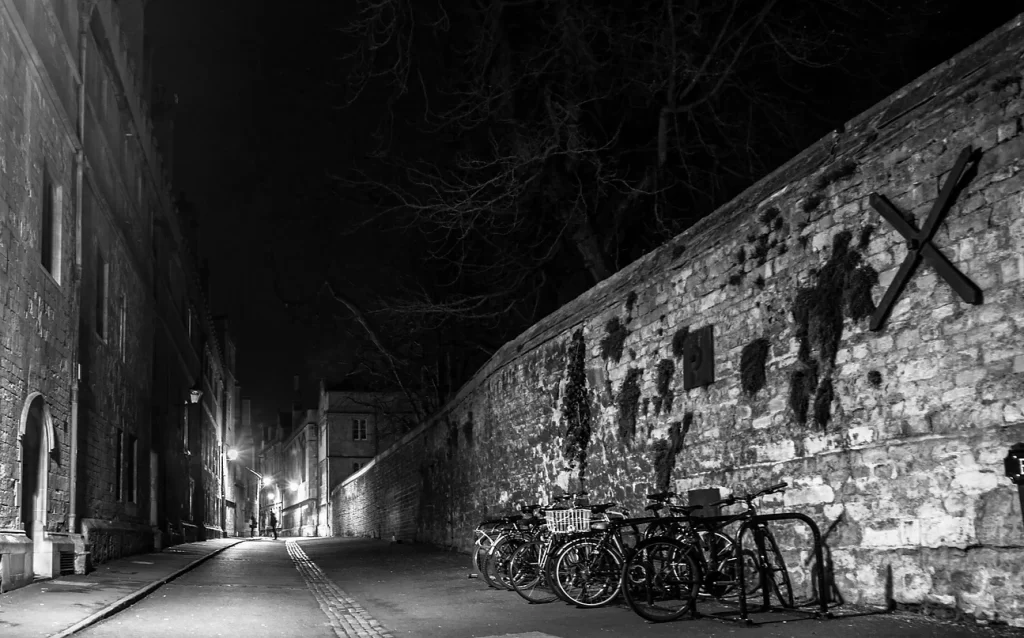Content warning: sexual assault, violence against women
On the night of Thursday 6 December 1827, Ann Crotchley, a young woman from Hereford, was out in the company of a new acquaintance, Harriet Mitchell. The narrative suggests that both Ann and Harriet were prostitutes. A little before midnight, Ann and her companion were given brandy by a party of students from Brasenose. The women stood outside the lodgings and brandy, in a teapot, was passed to them through the window.
With the brandy finished, Ann and Harriet went their separate ways. The combined effects of winter night air and a quantity of brandy were inevitable; Harriet collapsed drunk in New Inn Hall Street and Ann in Blue Boar Lane. Ann’s intoxication was noted by a watchman (the university, concerned for its young men, had established the Night Watch, its own police force. The Night Watch apprehended suspected prostitutes and locked them up beneath the Clarendon Building to be brought before the vice chancellor next morning). Some time later, the watchman returned and found that Ann was bleeding. She was carried to her lodgings and visited by a doctor. She died the next day. The post-mortem recorded the cause of death as internal wounds. The coroner recorded a verdict of murder.

Nobody was ever tried for Ann’s murder. The £100 rewards for information offered by both the City and the University went unclaimed. Some two weeks later, Ann’s poor body was exhumed so that six doctors could confer on the cause of wounds so terrible that Jackson’s Oxford Journal refused “from motives of delicacy” to describe them. Houstonne Radcliffe, the student who had dispensed the teapot full of brandy, left Oxford on the weekend of Ann’s death and never returned. Radcliffe’s father was the rector of Limehouse. Crossing Commercial Road from that Hawksmoor church at Limehouse, it is but a short step to Whitechapel and to the memory of other nineteenth-century women, murdered and mutilated.
In 2021, I joined the South Oxford branch of the Women’s Institute. Our first speaker, Olivia Durand from Uncomfortable Oxford, told the story of Ann Crotchley. Listening to that story, it was impossible not to make connections. Whatever the details of her biography, a part of Ann’s story is simple, universal, and tragically familiar. She was a woman alone at night in a street where someone stronger than she and with evil intent attacked her and injured her so terribly that she died.
On 6 December, in the company of members of South Oxford WI, I arranged an event on Blue Boar Street to mark the anniversary of the attack on Ann Crotchley. We tied ribbons on the railings to commemorate Ann and to remember all who are affected by violence against girls and women.

My motivation to make this act of remembrance had its origins both in personal history and in the interconnection of women’s histories spanning three centuries. In 1827 the night streets were unsafe for women. In 1969, as I know only too well, the night streets were unsafe for women. Today, the night streets remain unsafe.
I know the geography of London SW11 like the back of my hand, I was born and brought up there. And so, when I read of the friend that Sarah Everard had visited, I could picture the road and her walk towards home. The houses, the turnings, and the traffic on the Avenue. This was the route my sister and I took to school. I could also picture the road where one September night I was attacked by two men. That was in 1969 and I was fourteen years old. Nothing was ever done about the attack and for half a century I did not speak about it. Given the culture of those times it is unsurprising that nothing was ever done. A teenage girl should not have been out alone at 9:30 at night. Perhaps not, it was the eve of my father’s funeral and there were other preoccupations at home.
Now I have daughters and granddaughters; it is a new millennium and a new world. But actually it’s not. Last September, as I sat in the warm bright WI room listening to Uncomfortable Oxford’s telling of the story of Ann Crotchley, it was all too clear that the night streets of 2021 were no safer for Sarah Everard or Sabina Nessa than they were fifty or two hundred years ago. How on earth can that be?
I do not know where we find a solution, but I hope that by not forgetting Ann Crotchley we can remember her for herself and for many, many others: girls and women who were and are all very different and separated by time and place, biography and lifestyle. But in the matter of their vulnerability when out at night and alone, they are not separate at all.
There will be more initiatives to remember Ann and the Twitter page @RememberingAC will be regularly updated. The Museum of Oxford has kindly agreed that ribbons can be left on the Blue Boar Street railings until March 2022.
Written by Anne Peile





